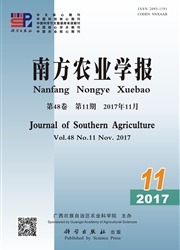

 中文摘要:
中文摘要:
【目的】了解上海沿海地区蛭弧菌的分布状况及其生物学特性,为蛭弧菌在防治水产动物病害方面的应用提供参考依据。【方法】采用双层琼脂平板法对采自上海沿海地区不同水域环境中的蛭弧菌进行分离,利用16S rRNA进行鉴定,并对其裂解谱、盐度耐受性、弧菌裂解差异性和培养方式进行研究。【结果】从上海沿海地区共分离到12株蛭弧菌,其中3株(4.2、5.1和3N.3)对弧菌属具有很强的裂解性,但对枯草芽孢杆菌、地衣芽孢杆菌、纳豆芽孢杆菌、脱氮副球菌、乳酸链球菌和保加利亚乳杆菌等有益菌无裂解作用。3株蛭弧菌在盐度1.5%~3.0%的范围内生长状况良好,5.1蛭弧菌株对溶藻弧菌的裂解能力较对副溶血弧菌和哈维氏弧菌的强,其差异达显著水平(P〈0.05)。宿主菌灭活可有效提高蛭弧菌的生长速度及其浓度,在培养第60 h达峰值;蛭弧菌与宿主菌(大肠杆菌)经异步发酵后,蛭弧菌在培养第72 h达峰值。【结论】从上海沿海地区分离获得的蛭弧菌具有良好噬菌能力,对主要的海水致病菌和淡水致病菌均具有侵染裂解能力,对有益菌无杀灭效果,且具有广盐性特征,可用于蛭弧菌微生态制剂的研发。
 英文摘要:
英文摘要:
【Objective】The present experiment investigated the distribution of Bdellovibrio in coastal areas of Shanghai, studied its biological properties, in order to provide reference for application of Bdellovibrio in prevention and treatment of aquatic animal diseases. 【Method】The researchers isolated Bdellovibrios from coastal areas of Shanghai using double layer agar plate, and used 16S rRNA gene sequence analysis to identify the bacteria. Lysis spectrum, saltinity tolerance, lysis diofference and culture mode of Bdellovibrio were studied. 【Result】Twelve strains of Bdellovibrio were isolated from the coastal areas of Shanghai. Among them, three strains(No. 4.2, 5.1 and 3N.3) had strong lysis effects to Vibrio, but had no lysis effects toward beneficial bacteria including Bacillus subtilis, B. licheniformis, B. natto, Paracoccus denitrificans, Streptococcus lactis and Lactobacillus bulgaricus. Three strains of Bdellovibrio had good growth condition in the range of 1.5%-3.0% salinity. Lysis effects of strain 5.1 toward Vibrio alginolytic were more significant than V. parahaemolyticus and V. harveyi,and the difference reached significant level(P〈0.05). Inactivation of host bacteria could effectively increase growth rate and concentration of the bacteria, and reached the peak after 60 h. After asynchronous fermentation of Bdellovibrio and host bacteria(Escherichia coli) Bdellovibrios amount reached the peak after 72 h of culture. 【Conclusion】Bdellovibrios from coastal areas of Shanghai has great phagocytic ability, which can infect and crack the main seawater pathogenic bacteria and freshwater pathogenic bacteria but cannot kill beneficial bacteria. It is euryhaline. Therefore, Bdellovibrios can be used in development of microbial agents.
 同期刊论文项目
同期刊论文项目
 同项目期刊论文
同项目期刊论文
 期刊信息
期刊信息
